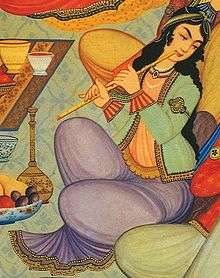Setar
For other uses, see Setar (disambiguation).
For the Indian instrument, see sitar.
|
A typical Iranian setar | |
| String instrument | |
|---|---|
| Classification | Plucked |
| Hornbostel–Sachs classification | 321.321 |
| Related instruments | |
| Tambouras, Tar, Tanbur | |
| Musicians | |
| Ebadi, Alizadeh, | |
Setar (Persian: سهتار, from seh, meaning "three" and tār, meaning "string") is a Persian musical instrument. It is a member of the lute family, which is played with index finger of the right hand. Two and a half centuries ago, a fourth string was added to the setar. it has 25 - 27 moveable frets which are usually made of animal intestines or silk. It originated in Persia before the spread of Islam.[1]
 |
setar audio
|
| Problems playing this file? See media help. | |
Uyghur variant
The satar (Uyghur: ساتار; Chinese: 萨塔尔) is an important instrument in 12 muqam. It is a bowed lute with 13 strings, one raised bowing string and 12 sympathetic strings, tuned to the mode of the muqam or piece being played.
Notable setar players

Hossein Alizadeh playing Setar
- Hossein Alizadeh
- Mohammad-Reza Lotfi
- Kayhan Kalhor
- Mirza Abdollah
- Houshang Zarif
- Sa'id Hormozi
- Ahmad Ebadi
- Abolhasan Saba
- Dariush Safvat
- Atâ Jangouk
- Jalal Zolfonun
- Dariush Talai
- Hamid Motebassem
- Omid Kamkar Lotfi
See also
See also: Lute § History and evolution of the lute
References
External links
| Wikimedia Commons has media related to Setar. |
- About Setar
- Setar.info
- Atlas of Plucked Instruments - Middle East - Iran
- About Persian Setar
- Experimental Music on Setar on YouTube
- Setar and Guitar Hybrid Instrument
This article is issued from Wikipedia - version of the 11/11/2016. The text is available under the Creative Commons Attribution/Share Alike but additional terms may apply for the media files.



